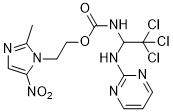Apcin is a ligand of Cdc20 and a potent and competitive inhibitor of the E3 ligase activity anaphase-promoting complex/cyclosome (APC/C). By preventing mitotic exit, it functions and is amplified synergistically when Ts-Arg-OMe is added together. By binding to Cdc20 and blocking substrate recognition, apiconin competitively inhibits ubiquitylation that is dependent on APC/C. Apcin has the ability to extend mitosis and resides in the D-box-binding pocket on the side face of the WD40 domain.
Physicochemical Properties
| Molecular Formula | C13H14CL3N7O4 |
| Molecular Weight | 438.653758525848 |
| Exact Mass | 437.017 |
| Elemental Analysis | C, 35.60; H, 3.22; Cl, 24.24; N, 22.35; O, 14.59 |
| CAS # | 300815-04-7 |
| Related CAS # | 300815-04-7 |
| PubChem CID | 2830389 |
| Appearance | White to off-white solid powder |
| Density | 1.68±0.1 g/cm3 |
| LogP | 3.411 |
| Hydrogen Bond Donor Count | 2 |
| Hydrogen Bond Acceptor Count | 8 |
| Rotatable Bond Count | 7 |
| Heavy Atom Count | 27 |
| Complexity | 513 |
| Defined Atom Stereocenter Count | 0 |
| SMILES | O=C(NC(C(Cl)(Cl)Cl)NC1=NC=CC=N1)OCCN1C(C)=NC=C1[N+]([O-])=O |
| InChi Key | ZEXHXVOGJFGTRX-UHFFFAOYSA-N |
| InChi Code | InChI=1S/C13H14Cl3N7O4/c1-8-19-7-9(23(25)26)22(8)5-6-27-12(24)21-10(13(14,15)16)20-11-17-3-2-4-18-11/h2-4,7,10H,5-6H2,1H3,(H,21,24)(H,17,18,20) |
| Chemical Name | 2-(2-methyl-5-nitroimidazol-1-yl)ethyl N-[2,2,2-trichloro-1-(pyrimidin-2-ylamino)ethyl]carbamate |
| Synonyms | Apcin |
| HS Tariff Code | 2934.99.9001 |
| Storage |
Powder-20°C 3 years 4°C 2 years In solvent -80°C 6 months -20°C 1 month |
| Shipping Condition | Room temperature (This product is stable at ambient temperature for a few days during ordinary shipping and time spent in Customs) |
Biological Activity
| Targets | APC/C; CDC20 |
| ln Vitro | Apcin is a novel, cell-permeable substance that prevents APC/C and Cdc20 from interacting. It has been shown that apicin causes apoptosis and inhibits the growth of OS cells. Therapy with apcin also significantly reduces OS cell invasion and motility. Moreover, after apcin treatment, Bim and p21 are upregulated in OS cells.[2] The ability of RL95-2 and HEC-1A cells to adhere and proliferate is decreased when CDC20 is inhibited with its inhibitor Apcin.[3] |
| ln Vivo | Apcin, a CDC20 inhibitor, prevents in vivo embryo implantation.[3] |
| Cell Assay | In 96-well plates, MG63 and U2OS (2.5×103 cells/well) are seeded and cultured for an entire night. Apcin is added to the medium in varying concentrations, and the cultures are left for 24, 48, and 72 hours, respectively. The cell viability is then evaluated using an MTT assay in accordance with the manufacturer's instructions. After that, each well receives 10 μl of MTT solution (0.5 mg/ml), which is added and incubated for four hours. After draining off the liquid supernatant, 100 μl of DMSO is added to each well to dissolve the crystals. Each well's absorbance at 490 nm is measured with a SpectraMax M5 Multimode Reader. |
| Animal Protocol |
8-week-old adult C57BL/6 female mice (weighing 20 to 25 g), 12-week-old adult C57BL/6 male mice (weighing 40 to 50 g) Uterine horn injection |
| References |
[1]. Nature . 2014 Oct 30;514(7524):646-9. [2]. Oncol Rep . 2018 Aug;40(2):841-848. [3]. Cell Biochem Funct . 2020 Aug;38(6):810-816. |
Solubility Data
| Solubility (In Vitro) |
DMSO: 88~125 mg/mL (200.6~285 mM) Ethanol: ~10 mg/mL (~22.8 mM) |
| Solubility (In Vivo) |
Solubility in Formulation 1: ≥ 2.08 mg/mL (4.74 mM) (saturation unknown) in 10% DMSO + 40% PEG300 + 5% Tween80 + 45% Saline (add these co-solvents sequentially from left to right, and one by one), clear solution. For example, if 1 mL of working solution is to be prepared, you can add 100 μL of 20.8 mg/mL clear DMSO stock solution to 400 μL PEG300 and mix evenly; then add 50 μL Tween-80 to the above solution and mix evenly; then add 450 μL normal saline to adjust the volume to 1 mL. Preparation of saline: Dissolve 0.9 g of sodium chloride in 100 mL ddH₂ O to obtain a clear solution. Solubility in Formulation 2: ≥ 2.08 mg/mL (4.74 mM) (saturation unknown) in 10% DMSO + 90% (20% SBE-β-CD in Saline) (add these co-solvents sequentially from left to right, and one by one), clear solution. For example, if 1 mL of working solution is to be prepared, you can add 100 μL of 20.8 mg/mL clear DMSO stock solution to 900 μL of 20% SBE-β-CD physiological saline solution and mix evenly. Preparation of 20% SBE-β-CD in Saline (4°C,1 week): Dissolve 2 g SBE-β-CD in 10 mL saline to obtain a clear solution. Solubility in Formulation 3: ≥ 2.08 mg/mL (4.74 mM) (saturation unknown) in 10% DMSO + 90% Corn Oil (add these co-solvents sequentially from left to right, and one by one), clear solution. For example, if 1 mL of working solution is to be prepared, you can add 100 μL of 20.8 mg/mL clear DMSO stock solution to 900 μL of corn oil and mix evenly. (Please use freshly prepared in vivo formulations for optimal results.) |
| Preparing Stock Solutions | 1 mg | 5 mg | 10 mg | |
| 1 mM | 2.2797 mL | 11.3986 mL | 22.7972 mL | |
| 5 mM | 0.4559 mL | 2.2797 mL | 4.5594 mL | |
| 10 mM | 0.2280 mL | 1.1399 mL | 2.2797 mL |
